Introduction
There are only about 400,000 African buffaloes in the whole of Africa, plummeting from 900,000 in 1999. 1https://www.iucnredlist.org/species/21251/50195031 Some sources estimate 44,000 make their home in Uganda. 2https://www.monitor.co.ug/uganda/news/national/uganda-wildlife-numbers-soar-due-to-enhanced-protection-4117108 Uganda is home to two subspecies of buffalo: the large Cape or African buffalo (Syncerus caffer caffer), found on the grassy savannah, and the smaller forest buffalo (S. c. nanus) found in Semliki National Park. 3https://www.nationalgeographic.com/animals/mammals/facts/african-buffalo The larger African buffalo can be found in the national parks of Murchison Falls, Kidepo Valley, and Queen Elizabeth. African buffalo live 11 to 22 years in the wild.
Fascinating Facts
A heavy-weight herbivore

Buffaloes weigh between 47 and 130 stone (300 and 830 kg) and rely on the freshest, greenest grass to stay healthy. Like their cow cousins, they spend a lot of time chewing the cud to extract all of the nutrients from their food. A good quality source of grass is the most important factor for buffalo survival. 4https://www.awf.org/wildlife-conservation/african-buffalo
Follow your nose
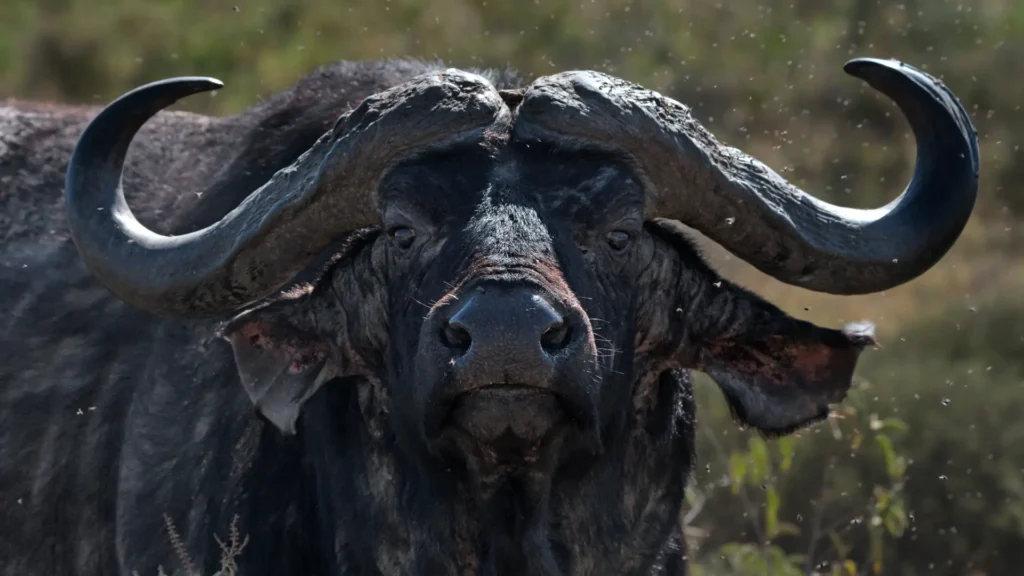
Buffaloes have poor vision and hearing but they make up for it with their acute sense of smell. They can follow their nose to food, and smell the scents of predators on the breeze. 4https://www.awf.org/wildlife-conservation/african-buffalo
Not a sun worshipper
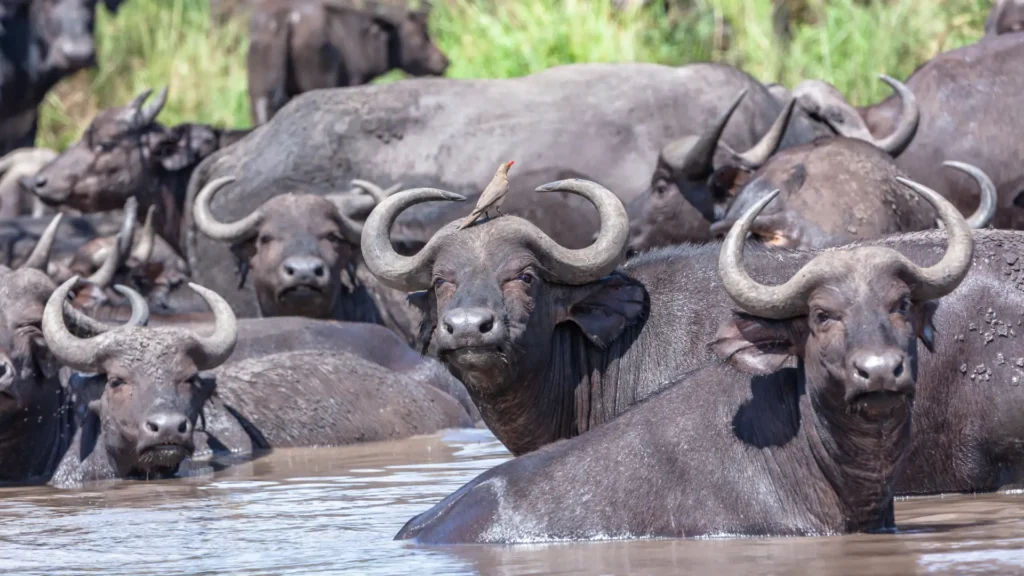
Despite being a native to Africa, African buffaloes don’t like the hot weather. They struggle to regulate their body temperature so prefer to feed at night when it is cooler. To stay cool during the day, they’ll rest in the shade and wallow in mud and watering holes.4https://www.awf.org/wildlife-conservation/african-buffalo
Safety in numbers

Buffaloes can be found in herds of usually 50 to 500 in Uganda (although this jumps to thousands of individuals in the Serengeti rainy season in Tanzania), because this way they are less likely to get attacked by a lion, hyena or other predator.3https://www.nationalgeographic.com/animals/mammals/facts/african-buffalo
A horny issue
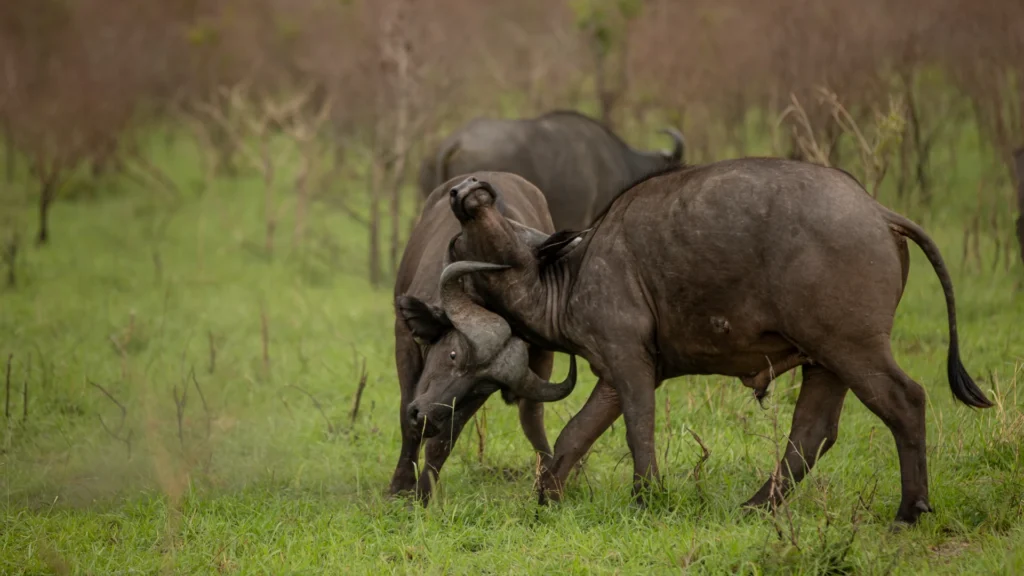
A buffalo’s curved horns can reach over five feet (160 centimetres) long and are used as a defensive weapon and to determine the dominant male for mating. In large males, the horns meet in the middle on top of the head to form a very hard shield, called a “boss”. This acts as a safety helmet when males are fighting for dominance or defending themselves from a predator. 3https://www.nationalgeographic.com/animals/mammals/facts/african-buffalo
His and her herds

Buffaloes live in two different types of herd. One is made up of females and their male and female calves. Females will stay in this herd for life, whilst males leave at about four years old and they make up the other type of herd. 5https://ugandawildlife.org/animals/buffalo/ A dominant male usually lives amongst the females, and all the other males stay out of his way in their own bachelor herd.
An unbreakable bond
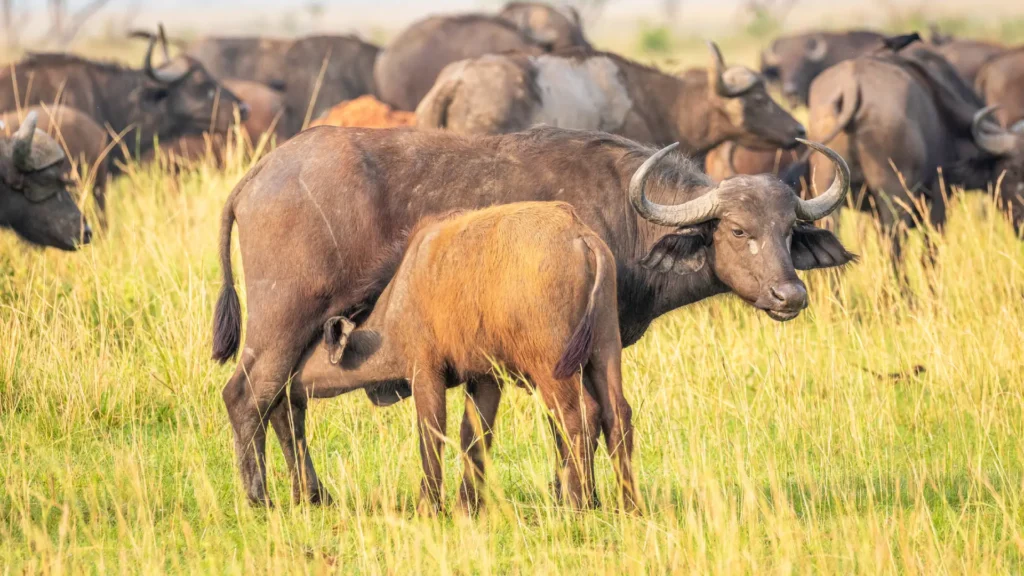
The bond between a mother buffalo and her calf is very strong. A pregnant cow (female buffalo), carries her calf for 11 and a half months before giving birth. Once born, she will keep them safe, hidden in grass and feeding them her milk. The calf will suckle from their mother for up to a year but will stay by her side even longer.4https://www.awf.org/wildlife-conservation/african-buffalo A female has her first calf at age four to five years and she usually gives birth only every two years.
Mad for mud
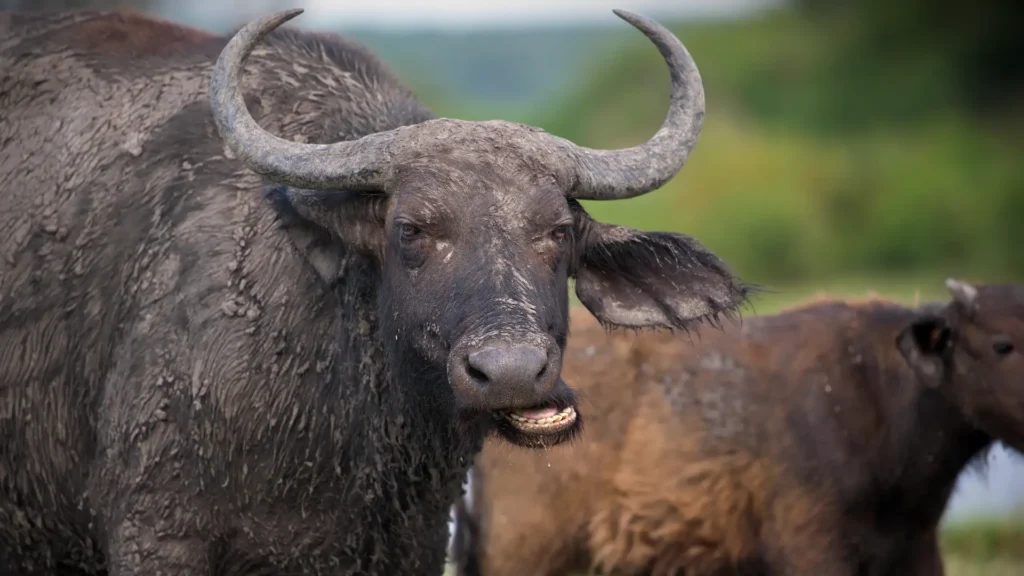
Buffaloes might not be sunbathers but they wouldn’t turn their nose up at a nice mud bath. Buffaloes are often spotted covered in mud with a bird sitting on their back. The dry mud helps them control parasites on their skin, and the bird does their bit to help by eating fleas, lice and ticks in exchange for a ride.3https://www.nationalgeographic.com/animals/mammals/facts/african-buffalo
Democracy rules
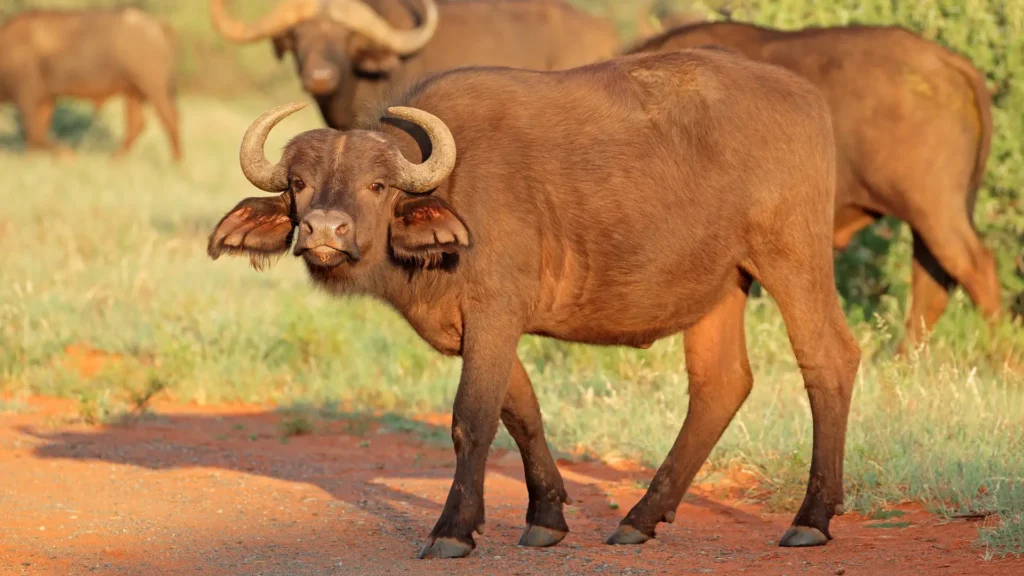
Although there is a dominance hierarchy in buffaloes, the decision on where to travel is decided democratically. Females ‘vote’ on where to travel next. Whilst resting the females stand, then shuffle around and sit again in the direction they want to travel. After about an hour of this behaviour, the females move in the direction the majority decide. This decision is not based on dominance or hierarchy. 6https://pubmed.ncbi.nlm.nih.gov/18811309/
Retired generals
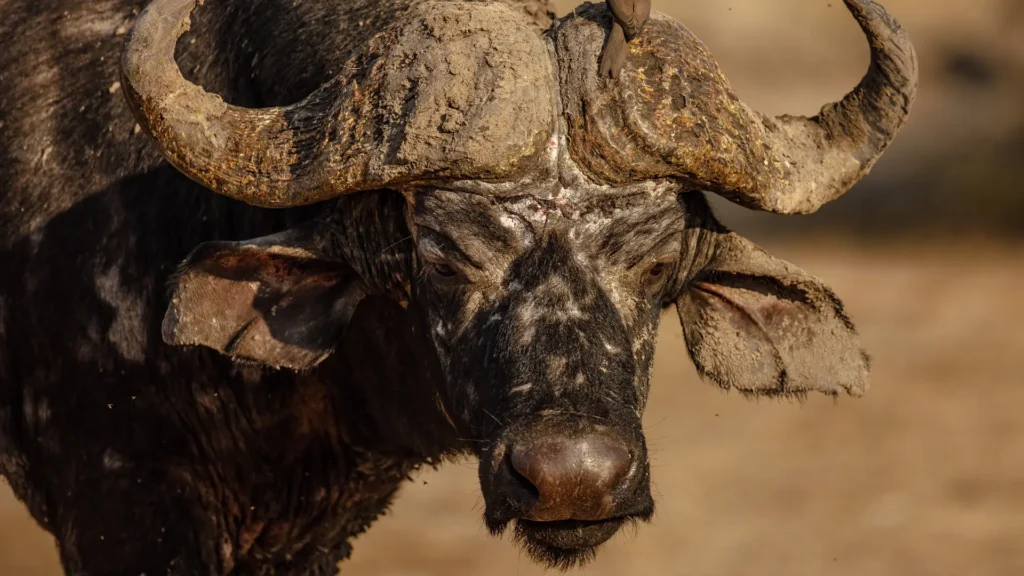
You will see elderly buffalo wandering the national parks of Uganda, sometimes alone but often in pairs or small herds. They have become too slow to keep up with the main herd and form a friendship in their old age with elderly kin. Occasionally, elderly females also join them.
Threats to African Buffaloes
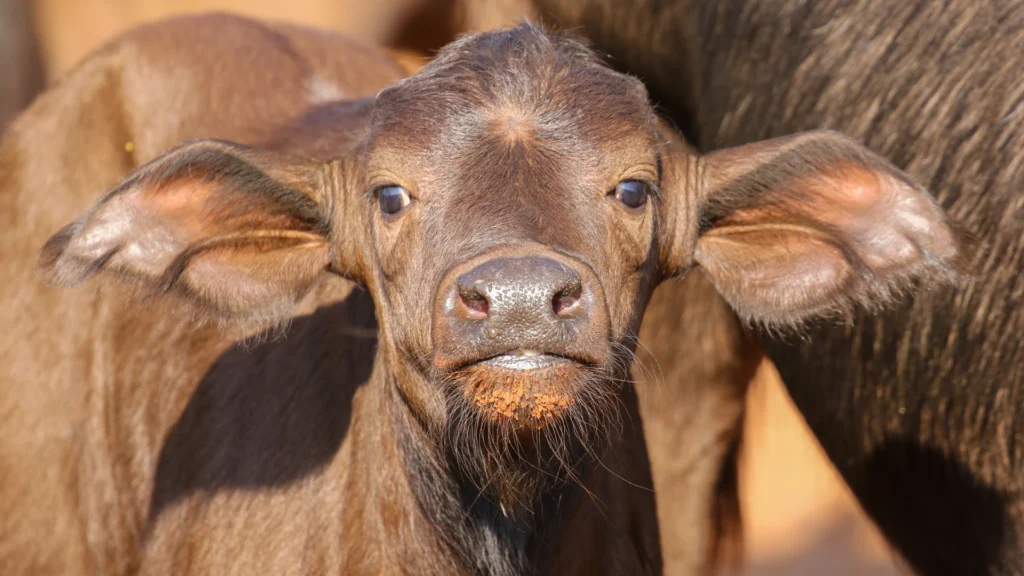
The African buffalo is not an endangered species, but it is considered “near-threatened” mainly because of human-wildlife conflict and habitat loss.1https://www.iucnredlist.org/species/21251/50195031
Habitat loss
As the human population in Uganda increases, more land is converted into settlements and farmland, and fragmented by roads. Bit by bit, the buffalo’s beautiful natural habitat is shrinking and being destroyed by the expansion of human infrastructure. To make matters worse, huge amounts of oil have been found under Murchison Falls, Uganda’s largest national park, and despite worldwide opposition by conservationists, French oil company TotalEnergies began drilling in the park in 2023. 7https://www.afrik21.africa/en/uganda-totalenergies-begins-drilling-for-oil-in-the-murchison-falls-national-park/
Fifty years ago, Uganda’s buffaloes could freely roam across the country in search of the greenest grass but today they have become isolated in parks and reserves, cut off from each other by human developments. It is becoming harder and harder for buffaloes to find enough food to sustain their large appetites in a restricted and diminishing environment. Without access to nutrient-rich grasslands, we could see African buffaloes disappearing from the once bio-diverse savannahs of Africa.
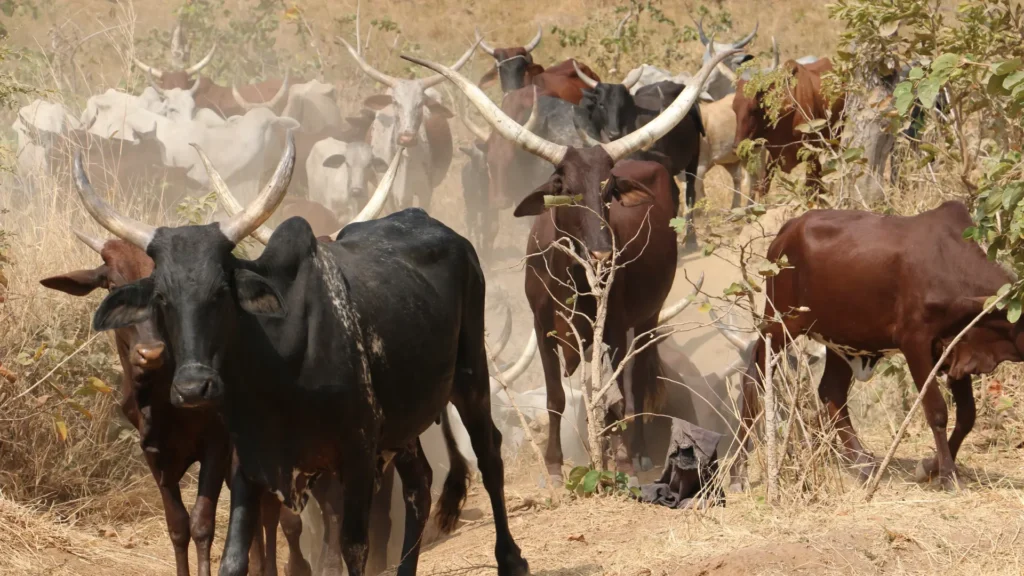
Human-wildlife conflict
African buffaloes often come into conflict with humans, specifically cattle and crop farmers. Rather than recognising buffaloes for the majestic animals they are, many locals view them as dangerous pests. The term ‘gentle giant’ doesn’t really apply to buffaloes: they can actually be very aggressive when provoked, and have been known to break through fences to reach the crops on the other side. African buffaloes reportedly kill up to 200 people a year, 8https://ugandaradionetwork.net/story/stray-buffalo-kills-peasant-farmer-in-lamwo and have earned the title of one of Africa’s most dangerous animals. The truth is, they’re a long way behind venomous snakes and malaria-carrying mosquitoes. 9https://www.discoverwildlife.com/animal-facts/most-dangerous-animal-in-africa
Of course, this wouldn’t be a problem if humans weren’t invading the buffalo’s natural habitat. When buffaloes are deemed a nuisance or dangerous they are either scared away by gunfire, or shot and killed on the spot. In 2014, a herd of buffaloes left Murchison Falls National Park in search of food and water because a “raging drought” had left them starving to death. When one of the desperate buffaloes entered a farm in Nyinezaramugongo village, he was instantly gunned down by the farmer. 10https://www.monitor.co.ug/uganda/news/national/buffaloes-torment-masindi-residents-1563398
Community projects to help farmers develop more sustainable agricultural growth without infringing on the natural habitat of Uganda’s wildlife are essential in resolving human-wildlife conflict in the country. Viva! Uganda’s Project KindHeart is at the centre of creating a generation of Ugandans who value their country’s wildlife enough to ensure that the interests of the animals are not pushed aside in favour of unsustainable economic and agricultural growth.
References
References
- 1
- 2
- 3
- 4
- 5
- 6
- 7
- 8
- 9
- 10

